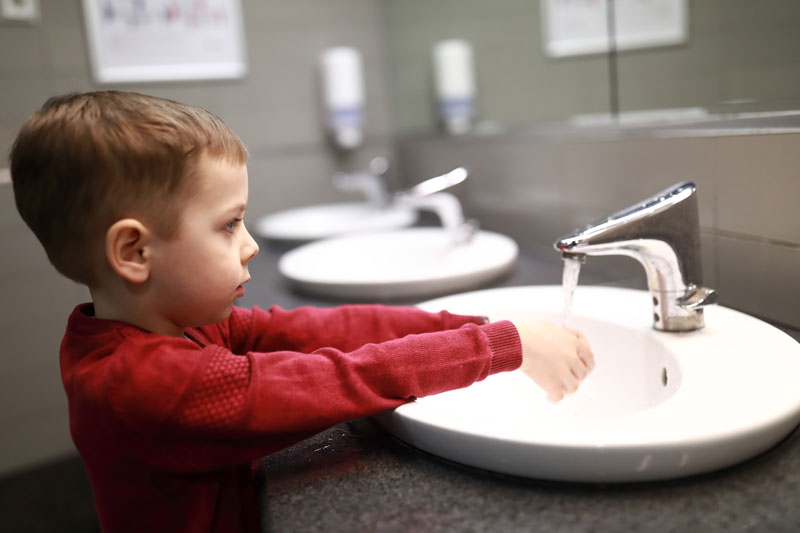
ANNUAL SURVEY REVEALS UNHEALTHY HABITS ARE OFTEN TIED TO FACILITIES AND FIXTURES, WITH CLEANER, MORE MODERN RESTROOMS CREATING BENEFITS BEYOND JUST HEALTH
While most Americans know how important it is to wash their hands after using the restroom, a new survey finds a disturbing number don’t always practice what they preach — particularly in public. The annual questionnaire finds that many often leave public restrooms without washing their hands and offers potential factors that determine this unhealthy behavior.
Bradley Corporation has been monitoring the hand-washing habits of Americans for 15 years through its annual Healthy Hand Washing Survey. The latest findings from its 2025 study provide insights into evolving behaviors and attitudes toward hygiene, particularly in response to seasonal illnesses and public restroom conditions.
Concerns about seasonal flu are driving hygiene behaviors, with 28% of Americans expressing significant worry — up from 23% the previous year. This concern has led to increased hand-washing diligence, as 79% report washing their hands more frequently or thoroughly in response to flu outbreaks, compared to 74% last year.
Concerns and Behavior
Hand-washing remains a critical component of personal hygiene, with 93% of respondents acknowledging its importance for overall health. On average, Americans wash their hands approximately 7.5 times per day, but nearly half (45%) admit to occasionally rinsing without soap. Men (53%) are more likely than women (38%) to skip using soap. Additionally, people tend to be more conscientious about hand-washing when in public (37%) than at home (20%).
“Hand-washing, using soap and warm water, is an easy and effective way to reduce the spread of disease-causing organisms that cause sickness, like the flu and norovirus,” said medical microbiologist Michael P. McCann, Ph.D., professor emeritus, Saint Joseph’s University. “Given the ease with which some of these organisms can be spread on solid surfaces, in food, and by other means, handwashing is something that everyone should do after activities like using the restroom.”

Though hand-washing remains one of the best ways to combat the spread of disease-causing organisms, peoples’ adherence to the hygiene practice depends on a host of factors. GETTY IMAGES
State of Public Restrooms
Public restrooms play a pivotal role in hand hygiene. While 81% of respondents say they always wash their hands after using a public restroom, that number drops to 70% among young adults (ages 18-24). Women (85%) are more consistent in this practice than men (77%). However, many avoid washing their hands due to common restroom issues, including a lack of soap, paper towels, or functioning sinks. Additionally, 35% of Americans frequently observe others leaving public restrooms without washing their hands — a significant increase from 27% in 2024.
When it comes to public restroom improvements, cleanliness and proper stocking of supplies remain top priorities. However, there is a growing demand for paper towels, even in restrooms with hand dryers, as half of respondents use them to avoid touching surfaces. The biggest frustrations in public restrooms include clogged or unflushed toilets, unpleasant odors, and an overall unkempt appearance.
“For those who skip hand-washing in a public restroom, the most common reasons are a lack of soap or paper towels, sinks that are dirty or out of service, overcrowding, and bad smells,” said Jon Dommisse, vice president of Business Development and Strategy for Bradley Company. “It’s no wonder that the most desired improvement in public bathrooms is keeping them more consistently clean and stocked with supplies.”
Good for Business
Restroom cleanliness significantly impacts consumer perceptions of businesses, as an unpleasant restroom experience negatively affects 84% of customers — particularly older adults — the survey found. Many equate poor restroom conditions with poor management, lack of customer care, and an overall lower opinion of the business. Moreover, 75% of respondents say an unclean restroom makes them reconsider returning, while 42% would complain to management, and 35% would share their dissatisfaction with friends.
Conversely, well-maintained restrooms contribute to customer loyalty, with half of respondents stating that a positive restroom experience increases their likelihood of returning. Notably, 60% say they intentionally stop at businesses known for clean restrooms, and 71% indicate that a clean restroom makes them more likely to make a purchase. Industries such as health care, hospitality, and restaurants receive the highest marks for restroom cleanliness, while gas stations and retail stores rank lower.
Touchless Fixtures
The preference for touchless restroom fixtures remains strong, with 79% of respondents considering them important and 75% preferring them over manual options. Two-thirds say they are more likely to return to a business that features touchless fixtures, especially for faucets, soap dispensers, and flushers. However, expectations for functionality are high, with 80% of users expecting these fixtures to work properly.
The findings from Bradley Corporation’s 2025 survey underscore the importance of maintaining high sanitation standards, ensuring reliable touchless technology, and addressing customer preferences for paper towels and overall restroom privacy. By prioritizing these factors, businesses can enhance public confidence, improve customer retention, and contribute to better public health outcomes across the nation.
Prioritizing Public Hygiene
The findings from Bradley Corporation’s 2025 survey underscore the critical need for businesses and public facilities to maintain high sanitation standards, ensuring that restrooms remain clean, functional, and accessible at all times. Reliable touchless technology plays a pivotal role in enhancing user confidence, as modern consumers increasingly expect a seamless and hygienic restroom experience.
Addressing customer preferences for paper towels is another key factor, with many individuals using them to avoid direct contact with restroom surfaces, further emphasizing the demand for enhanced hygiene protocols. Additionally, overall restroom privacy continues to be a growing concern, with users preferring stall designs that minimize visibility gaps and provide a greater sense of security. These elements collectively contribute to a more positive and reassuring public restroom experience, benefiting businesses by fostering trust and repeat patronage.

ABOUT BRADLEY
For more than 100 years, Bradley has been known as a leader in advanced commercial washrooms and comprehensive emergency safety solutions that make public environments hygienic and safe. www.bradleycorp.com

Mike Flenniken is a staff writer, Marketing and Communications, for IAPMO. Prior to joining IAPMO in 2010, Flenniken worked in public relations for a group of Southern California hospitals and as a journalist in writing and editing capacities for various Southern California daily newspapers.
Last modified: April 8, 2025
